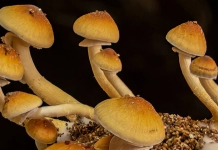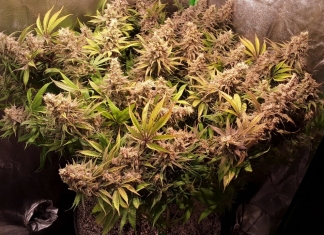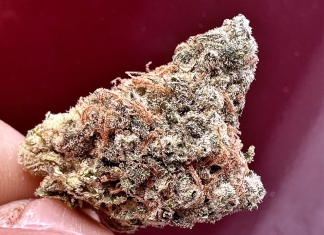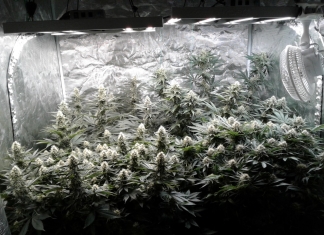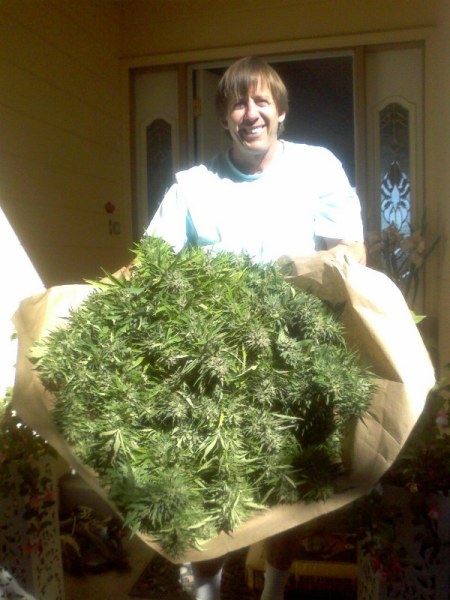It was a difficult growing season.
It seems strange to write that on a beautiful late November day, as the bright sunshine and scattered clouds mottle the mountain in shades of brown, red and gold and I can see the snow glint on the peaks which rise above the central plain across the gulf.
But it was, as I say, a difficult season.
My plan was to test out Vulx across a wide range of fruit and veg. One of my raised beds was prepared with Vulx and planted out with cucumbers, tomatoes, peppers and strawberries, together with a couple of Jack Herers. The second bed was planted identically, without Vulx, as a control. But you know how it is with plans.
Now as a fairly experienced outdoor grower, you expect the usual pests. Starting in September, caterpillars demand a daily check, picking open the developing buds and extracting the little green and brown fellas. Spider mites got involved a couple of years ago. (Never grow rosemary near your crop. Mites love Rosemary). However this year there was a rather larger problem.
Over a couple of nights in early June, a wild boar from the forest behind the property decimated the raised beds, completely destroying all the crops and the beds themselves. He also dug up half a dozen of my girls which were potted up under the pergola, as well as my herbaceous border. He ran riot through the village, ruining many lovely gardens and allotments. My neighbour’s vineyard was completely destroyed.
Now being English, I’m no hunter and have fired a gun on only one occasion. That was in the Russian Caucuses many years ago. But that’s another story. However, when the hunting season began, I cooked a boar stifado. I hope it was him.
Then there was the weather. From May to late October you can usually rely on constant sunshine, temperatures in the late 20s to early 30s with a very occasional, dramatic evening thunderstorm. This year the temperatures were consistently 36-42 degrees, even here, nestling in green nowhere at 700m elevation. And the rains began early in September and carried into late October. These were often accompanied by a sudden drop in temperature, (the smell of wood smoke from stoves filled the village air a few months earlier than usual), resulting in hailstones ripping through leaves of all the plants, flowers and remaining veg. The consistent downpours and high humidity meant only one thing. Rot. One of the most dispiriting feelings in the world is finding that dying fan leaf popping out from a fat bud and prizing it open to see that mold has reduced the interior to brown dust.
Finally, my trusty old Nikon proved not so trusty and gave up the ghost, leaving me with a horrid ipad camera. Christmas is coming, but not in time for the flowering shots.
It was, as I say, a difficult summer for my side-by-side Vulx test.
What Is Vulx?
This is what the Vulx website says:
Vulx is not: glacial rock dust, “paramagnetic lava rock”, soil remineralization, water polymer crystals, pumice, perlite or vermiculite or a fertilizer.
Vulx is a special mixture of isolated volcanic deposits which have been sourced, mixed, and refined by a Master German Chemist, with proven ability to greatly enhance availability and uptake efficiency of water and nutrients.
With Vulx mixed in your medium, plants have better access to what they need.
Vulx claims increased harvests and reduced watering needs. What’s not to like? Let’s find out if the claims stake up.
I will add here that Vulx’s owner is a splendid chap called Beau. He is not only incredibly knowledgeable and helpful, he is working round the clock to give his business scale. So in the interests of full disclosure, I wanted this little trial to work, not just for my buds but for his business.
The Soil
Here in green nowhere there is no access to any kind of cannabis related shop for hundreds of miles and in another country. Over the years I have mixed and refined my own soil and teas. (There’s a rather good resource to help with this known as 420 Magazine). The only manufactured thing that goes into it is perlite.
Once the little seedlings are strong enough and acclimatized, they are transplanted into a mixture of my own garden compost, leaf mulch, peat, beautiful black forest humus from the surrounding woods, horse manure, worm castings, and desiccated shrimp shells from the bountiful Aegean. After early veg, they are again transplanted into their final pots.
The soil is fed with two teas: one made from nettles, borage and comfrey, the other from the horsetail ferns which surround the mountain streams and springs and are full of silica for strength, health and pest resistance. During veg, the girls, (and the tomatoes), are also foliar fed once a week or so with my own kelp tea.
Here we are, mixing the soil early in the year:
The Site
The girls are grown in large pots under the pergola, completely hidden from public view, even to those tourists who very occasionally use the track at the back of the garden to visit the beautiful 17th century chapel behind the property. In the high summer it gets direct sunlight from 7am to 9pm.
Here’s a sense of the spot:
The Vulx Test
After the boar, I was left with two side-by-sides in pots. Two White Widows and two Jack Herers. I have grown both before and am used to their particular vagaries and needs. Vulx was mixed into the soil for both the first and second transplants. I’m a grower of all things by experience and feel. (I’d never make a measuring hydro man). For the mixing however I assiduously followed the Vulx instructions: 5% weight by volume.
In line with my relaxed approach, plants get watered not according to any regime but when they need it. When the pots are light and the leaves are just starting to droop. Each one is an individual and has its own needs.
Did the Vulx reduce watering needs?
Initially, I thought not. Recording (not like me) the no Vulx/Vulx plants waterings, they were pretty much together. I put it down to the exceptionally high summer temperatures.
However, as the Vulx plants became larger than their partners, one would expect them to need more water. This was absolutely not the case. So whilst I was still lugging mountain spring water up the path, I was collecting no more than I would have usually done.
Strawberries & Tomatoes
No question here that the Vulx soil encouraged vegetative growth.
Strawberries
Lost to the boar. Vulx on right. Vulx plant more vigorous and resisted the bugs.
Tomatoes
Lost to the boar. Vulx on left.
Cannabis
The plants grown with Vulx showed appreciably more vigorous vegetative growth, which with associated topping and training, of course resulted in many more buds. I again apologize for the terrible photos. No decent camera and constant heavy rainstorms.
White Widows (August)
Sadly, these two were both ruined by rot in October, so there is no valid harvest data.
Vulx on left.
White Widows (September)
Vulx on left.
Just a later snap of a rot-surviving bud. Beauty amidst decay.
A White Widow and Jack Herer (both Vulx) enjoying the evening.
Jack Herers (late September)
Apologies. Horrid ipad in a storm photo.
Three Jack Herers. Same pots etc. Vulx on the left. It was larger and, as you can see from the colour, healthier to the end.
Jack Herers (late October harvest)
Here is the only valid harvest data. The Vulx Herer undoubtedly showed greater veg growth, I’d estimate a good 15% more than its sisters (see photo above). Its roots were the only ones to find their way through the drainage holes and into the ground soil, as I discovered by the ripping sound when I took the pot for harvesting.
Jack Herer Vulx plant:
Jack Herer non-Vulx plant:
In summary – Three Jack Herers were grown in identical pots and spot. Vulx added to one.
Vulx plant was healthier to the end, resisted the rot better, grew about 15% larger and yielded (wet with stalks, rough for comparison) about 3lb vs about 1.3lbs.
Conclusion
Thank you, Beau, for getting your Vulx to me out here in nowhere. I was happy to try it out for a 420 Magazine review. I was delighted to discover it worked for me.
I am a casual grower. This is not a scientific study by any means. It’s just my experience over the summer and autumn of 2019.
And my experience of Vulx was a good one.
I can say that, for me, Vulx:
- Encouraged much better vegetative growth
- Plants were healthier
- Therefore Vulx plants delivered a considerably heavier harvest
- Meant less watering in late veg and flowering than one would expect for larger plants
I look forward to repeating the experience on a greater number of plants, (and with better photos), in 2020.
420 Magazine Review by: Teddy Edwards
For More Information: Vulx





